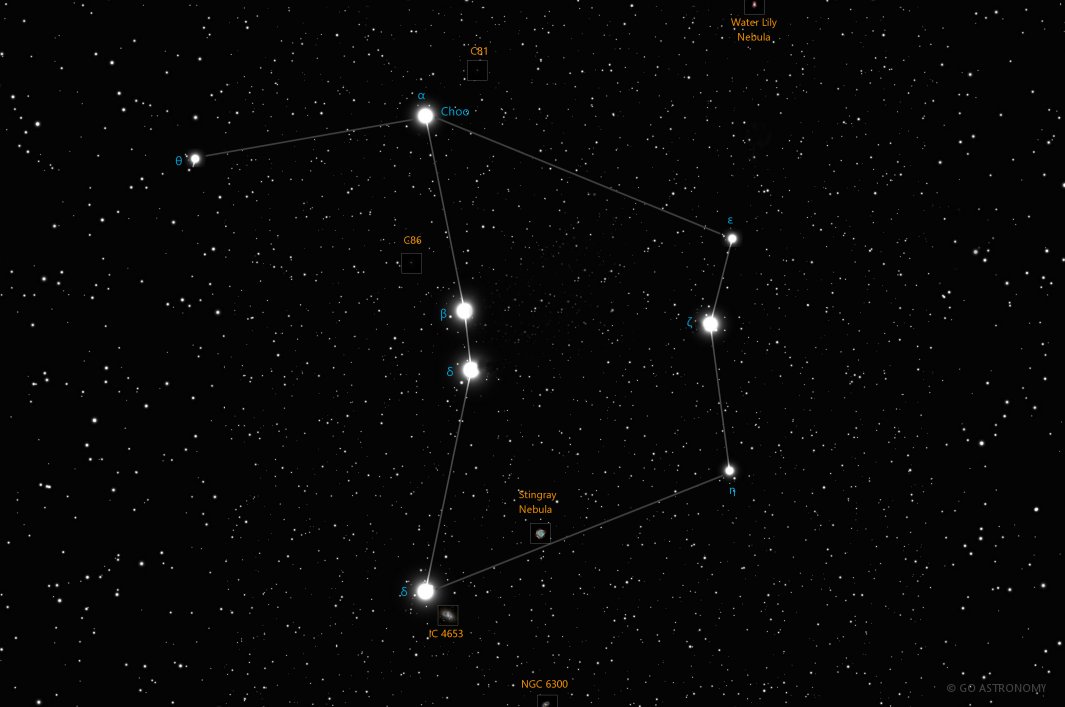Ara, the Altar (Ara)
(AIR-uh)
The Southern constellation of Ara, the Altar, is best viewed in Summer during the month of July.
Ara is the 63rd largest constellation. It's brightest star is Beta Arae at magnitude 2.80. The boundary of the Ara constellation contains 7 stars that host known exoplanets.
Red hypergiant Westerlund 1-26 is the 3th largest known star in the universe at 1,500 times the size of the Sun.
- Pronunciation:
- AIR-uh
- Meaning:
- Altar
- Genitive:
- Arae
- Abbreviation:
- Ara
- Constellation Family:
- Hercules
- Hemisphere:
- Southern
- Quadrant:
- SQ3
- Visibility:
- 25° N - 90° S
- Best viewing month*:
- July
- Area:
- 237 sq. degrees
- Size:
- 63rd largest
- Right Ascension (avg):
- 17h 14m
- Declination (avg):
- -55°
- Brightest star:
- Beta Arae (2.80)
- Stars with planets:
- 7
- X-ray stars:
- 4 stars
- Gamma-ray stars:
- 1 stars
- Messier objects:
- |
Brightest Stars in Ara
The 10 brightest stars in the constellation Ara by magnitude.
- Star
- Magnitude
- Spectral class
- Beta Arae (β Ara)
- 2.84
- K3Ib-II
- Alpha Arae (α Ara)
- 2.84
- B2Vne
- Zeta Arae (ζ Ara)
- 3.12
- K5III
- Gamma Arae (γ Ara)
- 3.31
- B1Ib
- Delta Arae (δ Ara)
- 3.6
- B8V
- Theta Arae (θ Ara)
- 3.65
- B2Ib
- Eta Arae (η Ara)
- 3.77
- K5III
- Epsilon Arae (ε1 Ara)
- 4.06
- K4III
- Sigma Arae (σ Ara)
- 4.56
- A0V
- Lambda Arae (λ Ara)
- 4.76
- F3IV
Star Clusters in Ara
The most notable and easy-to-find star clusters in the constellation Ara . Also see all star clusters.
Nebulae in Ara
Notable and easy-to-find nebulae in the constellation Ara . Also see all nebulae.
Galaxies in Ara
The most notable galaxies in the constellation Ara. Also see all galaxies.
Black Holes in Ara
These are the most well-known smaller (non-supermassive) black holes in the constellation Ara. Although black holes cannot be seen directly, the smaller ones are at the center of some star clusters and supernova remnant nebulae, which can be seen. Supermassive black holes are at the center of most galaxies, such as Sagittarius A* at the center of our Milky Way galaxy. Also see all black holes.
- Black hole
- Type
- V821 Ara
- stellar
- XTE J1650-500
- stellar
The Altar Constellation
The constellation Ara, Latin for 'The Altar,' is a small, southern constellation that has both historical significance and interesting astronomical features. It is relatively faint, with no stars brighter than the third magnitude, but it can be seen from many locations in the Southern Hemisphere and from southern parts of the Northern Hemisphere.
History and Mythology
Ara is one of the 48 constellations originally listed by the 2nd century Greek astronomer Ptolemy, and it remains one of the 88 modern constellations defined by the International Astronomical Union. In ancient Greek mythology, Ara is associated with the altar where the gods first made offerings and formed an alliance before their battle against the Titans. The Milky Way is said to represent the smoke rising from the offerings on the altar.
Location and Features
Ara is located in the third quadrant of the Southern hemisphere, specifically between latitudes +25? and -90?. It is surrounded by several constellations, including Scorpius, Norma, Triangulum Australe, Pavo, Telescopium, and Corona Australis.
The brightest star in Ara is Beta Arae, which is a second magnitude star. Beta Arae is a K-type supergiant, which means it's a highly luminous star that has exhausted the hydrogen at its core and moved off the main sequence. It's located approximately 600 light years from Earth.
Deep Sky Objects
Despite its small size and relative faintness, Ara contains several notable deep sky objects. This includes the globular clusters NGC 6397 and NGC 6352, both of which can be seen in amateur telescopes. NGC 6397 is particularly notable, as it is one of the two nearest globular clusters to Earth, the other being M4.
Additionally, Ara is home to the Stingray Nebula (Hen 3-1357), the youngest known planetary nebula. This fascinating nebula is named for its resemblance to a stingray, and it provides valuable insights into the late stages of stellar evolution.
Observing Ara
Due to its location, Ara is primarily visible in the Southern Hemisphere. The best time to view Ara is during its culmination in the months of July and August. Despite its relative faintness, under clear, dark skies, its main stars can be seen without the aid of a telescope.
Observers using a telescope will be able to view Ara's deep sky objects, such as its globular clusters. These present a more challenging but rewarding target for astronomers.
* Constellation shown for northen hemisphere skies. For the southern hemisphere, constellations appear rotated 180 degrees (upside-down and left-right reversed) from what is shown. Remember that seasons are reversed too - summer in northern latitudes is winter in southern latitudes.
** Circumpolar constellations are visible year-round in the hemisphere listed (and not at all in the opposite hemisphere).





